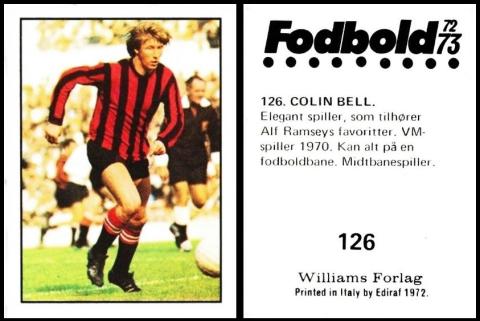
The clue here was a bit obscure, but it was the player`s surname, "Bell", which is the most familiar, and oldest, style of purpose built tent. Before that the idea was to hang a large sheet over a rope and use it as a shelter, on one side at least. In a bell tent, there is a pole in the middle, which allows the occupants plenty of room, and another pole supports the doorway, whilst ropes pull the canvas walls outwards, making them look like a bell, slightly.
Colin Bell probably had little to do with camping. He played for Bury from 1963, and in 1966 was transferred to Manchester City, where his career was cruelly ended by a mid match tackle in 1975 - though he did return on and off, and in 1980 he was signed by the North American Soccer League`s San Jose Earthquakes, who had already managed to attract none other than George Best. However he played just five games, and then retired. He moved into coaching with Manchester City, and was awarded an MBE in 2004. He died the next year, from bowel cancer.
Now there seems to be a bit of confusion over Williams Forlag and Williams Forlags AB, not helped by the fact that both are into publishing and both Scandinavian. Ediraf was easier, as they were the printer, and they were based in Turin. They also printed a British football set, "Football 73", for Top Sellers.
In fact, after more research, both were subsidiaries of Williams Publishing, part of Warner Communications, which clears up my original wondering at how they got to publish the DC and Marvel Comics. Williams Forlag was the Norwegian branch, it started in the early 1970s, and ran until about 1976 - whilst Williams Forlag AB was the Swedish branch, which had started first, in 1965.
I say opened, but they were already in business, they were just renamed to Williams, before that they had been parts of Gilberton World-Wide Publications. However when they ran into a slight difficulty the company was renamed to Williams after the founder`s son.
This is an unusual set; the title, "Fodbold" is Danish and it is a combination of "Fod" which means `foot` and "Bold" which means `ball`. The cards measure 65 x 48 m/m. and it does not turn up much as a complete set in the British Isles, you will mainly find the British players, which have been bought in from overseas. The first fifty-eight cards are all Danish, the national team, followed by selected players from the Danish League. Cards 59 -110 are League Division One players from the UK, in teams that range alphabetically from Arsenal to Liverpool (though include two cards for Norwich City, and immediately after are eleven cards which form a kind of fantasy World Team section; this includes three other British players, namely Gordon Banks, Bobby Moore, and Bobby Charlton. Cards 122 - 173 are a return to the League Division One players from the UK, this time the other end of the alphabet, teams Manchester City to Wolverhampton Wanderers, though again two cards are out of place, these being Birmingham City. Looking closely at these I find that the Birmingham City cards are between Newcastle United and Sheffield United, where Norwich City would have slotted neatly in - but it is not so clear cut if you slide Birmingham City into the first selection. From card 174 you return to the Danish League Division Two, until the final card, number 215.
The set may seem to stop there, but it actually also included twenty seven unnumbered cards - eleven football badges - and sixteen cards that make up a puzzle of Alan Ball. Why Alan Ball, I know not, though perhaps it was because at the end of 1971 he became the most valuable player, at least in the UK, when he was transferred from Everton to Arsenal for the then record of £220,000.
